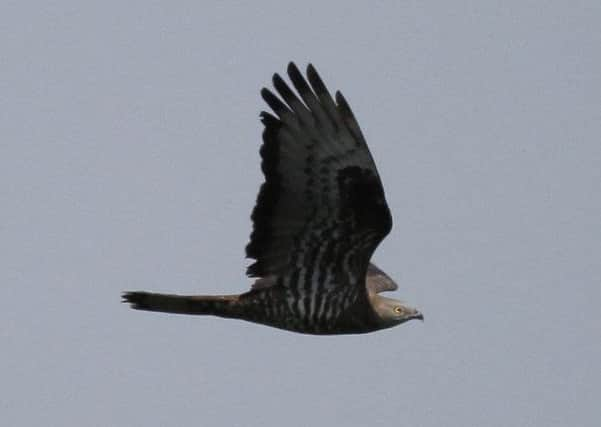Birdwatch: Harvest time for species that guzzles wasps


Common buzzards are also regularly seen from the Wykeham viewpoint so it is worth knowing how to tell the two apart.
One way is to compare how they fly. Common buzzards almost always keep their wings slightly lifted in a ‘V’ while the honey buzzard keeps its wings flat like the red kite to which it is more closely related.
Advertisement
Hide AdAdvertisement
Hide AdAnother difference is that the honey buzzard’s tail has two or three dark bands on the underside and the tail is longer than the width of its wings. But, such is the wide variation in the plumage of common buzzards, it is tricky to pick this feature out.
In many ways, particularly in its manner of feeding, the honey buzzard is a highly unusual bird of prey. Its principal prey in summer is invertebrates, in particular wasps and hornets, eating adults, pupae, larvae and even the comb in the nests, the latter habit giving the bird its name although it will supplement its diet with birds and their eggs, especially when it has just arrived back from Africa.
It finds wasp nests by flying slowly at no more than treetop height scanning for flying insects or even wandering along on the ground. Once it finds a nest it will dig it out using its long thick claws while thick scaly feathering around the head, beak and legs protect it from stings. Another precaution it takes is to snip off the sting of an adult wasp before swallowing it.
The best wasp harvest is between this month and August. It is during this period that honey buzzards pair up with elaborate aerial displays, flying up then suddenly swooping down and, as the bird reaches the top of the ‘wave’, it lifts its wings high over its back and shakes them before beginning its descent.
Advertisement
Hide AdAdvertisement
Hide AdThe nest is often on top of an old crow or common buzzard nest and two eggs are laid and mainly incubated by the female.
In this country honey buzzards are quite a rare bird with around 60 pairs a year but they are relatively common elsewhere in Europe, as demonstrated from mid-August onwards when they begin to leave Europe for Africa again.
Depending on the prevailing winds large numbers of honey buzzard from Scandinavia can be brought here during migration and at these times can become much more widespread.
The first quail have been making their distinctive wet-my-lips calls in several places while a marsh warbler was trapped and ringed at Wintersett reservoir, West Yorkshire.
Advertisement
Hide AdAdvertisement
Hide AdAn Icterine warbler, common rosefinch and nightingale were all reported singing in the Kilnsea area.
Starlings seem to be having a good breeding season with large number of juveniles seen among flocks across the region. Numbers will increase still further in autumn when they are joined by starlings from Europe.